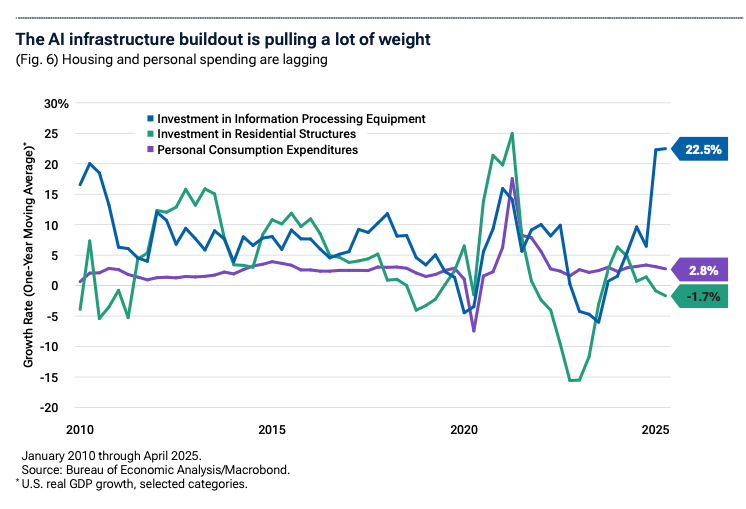Minds, machines and market shifts: T. Rowe Price's 2026 global market outlook
Investors are still reeling from a year that has thrown up numerous curveballs and will likely continue to do so until the clock hits midnight on 31 December. But such is the speed at which markets move that they already need to have one eye on where things go next year.
In keeping with that forward-looking perspective, T. Rowe Price has released its 2026 global market outlook report, which breaks down the key themes, macro stories and concerns across equities, fixed income, private equity that investors need to keep an eye on.
And the overarching message is one of relative optimism, largely driven by the belief that AI is turning the corner from potential to profitability, in the words of Eric Veiel, T. Rowe Price's Head of Global Investments.
"Artificial intelligence (AI) is no longer just a promise—it’s powering measurable change across the global economy and financial markets," Veiel writes in the introduction. "After years of hype and speculation, the AI boom has crossed a critical threshold: Ideas are becoming infrastructure, and investor focus is shifting from AI’s potential to its profitability."
Not all investors would agree with that assertion, but Veiel suggests the market's current concerns will likely persist into 2026.
"The age of speculation is giving way to real‐world results, but investors must be mindful that old challenges—valuation, inflation, and geopolitical uncertainty—remain firmly in play."
Below are the key takeaways from T. Rowe's extensive 2026 outlook, covering off the global economy, AI, equities, fixed income, private equity and asset allocation.
The global economic outlook
A muddled growth picture in 2025 should persist in 2026, though certain regions are likely to fare better than others, says T. Rowe's macro team.
"Look for the U.S. economy to shake off its growth scare from the second half of 2025 and outperform expectations in 2026 as AI spending and fiscal expansion provide support.
"Europe, on the other hand, could lag consensus estimates because the front‐loading of tariffs has drained meaningful manufacturing demand. In emerging markets, inflation and debt levels are reasonably under control, but tariffs are a wild card whose effects may take years to play out."
The US outlook arguably has the biggest impact for Australian investors, and T. Rowe sees the confluence of big capex and recent rate cuts as big drivers for US growth next year.
"AI‐related capital expenditure (capex) has significantly boosted U.S. growth in 2025, and the capex incentives in the “One Big Beautiful 12 Bill Act” (OBBBA) should only strengthen that tailwind next year."

"The beneficial effects of the Federal Reserve’s (Fed) late‐2025 rate cuts will add to the U.S. economy’s health in 2026. The labour market may be able to pull out of its stalemate between a low level of jobs added and minimal layoffs, moving toward expansion."
But there's a persistent spectre still looming over the US outlook that could dash growth hopes: inflation.
"Inflation remains an overarching risk. With U.S. government debt at more than 120% of gross domestic product (GDP) even as inflationary policies such as tariffs and immigration restrictions have a growing impact, the Fed will have difficulty returning inflation to its 2% target. Expectations for rate cuts in 2026 seem to overestimate the amount that the central bank will ease, and it may not be able to lower rates next year at all."
The outlook for AI
It has become 2025's dominant theme and forms much of the foundation of T. Rowe's 2026 outlook, but where does AI find itself as a technology and market narrative?
The T. Rowe view is bullish, even as it acknowledges that AI has created speculative activity and the pressure is on "to carve out clear paths to monetisation".
"We believe AI remains on track to become the biggest productivity driver for the global economy since electricity. It has the potential to be transformative not just for tech firms, but for nearly every sector—healthcare, finance, manufacturing, education, and beyond—by unlocking new solutions to complex challenges."
While AI remains a nascent industry, the T. Rowe view is that 2026 marks the year that it enters a new phase.
Three years after the launch of ChatGPT, the narrative around AI is beginning to shift from “what’s possible?” to “what’s profitable?”
One potential development of note could be the use of the public bond market and private credit to fund AI-related capex, which brings with it additional growth opportunities as well as added pressure on AI companies to deliver revenue and profit.
"While the AI sector’s expanding capex and reliance on debt will introduce new risks, we believe the long‐term growth prospects remain compelling—especially for the hardware suppliers and hyperscalers at the heart of the ecosystem. For investors, this means focusing not only on visionary technology, but also on execution, financial resilience, and clear paths to monetisation as AI enters its next chapter."
The outlook for global equities
On global stocks, the outlook is similarly bullish, again driven in large part by AI, as well as stimulus-driven infrastructure spending in the US.
In 2026, we anticipate broader market participation and a widening spectrum of opportunities—both within AI‐related sectors and across a diverse range of industries and regions.
Big tech will look to shore up their positions through extended capex, which in turn opens up new opportunities in adjacent industries.
"Within AI, we have entered a period of “existential investment”—a phase in which major technology companies, or hyperscalers, must invest heavily to safeguard their long‐term value."
"The next chapter of AI leadership may favour semiconductor enablers, power infrastructure, and automation suppliers—where earnings potential remains under-appreciated."
Opportunities also present themselves outside the US, where AI-adjacent companies across chips, robotics and infrastructure could benefit from increased capex.
Japan "stands out for attractive valuations, robust cash flow, and improved corporate governance". Europe is "quietly entering a new expansion phase" and China "remains a tactical opportunity set".
Even emerging markets like Brazil and India look "broadly positive" amidst global supply chain diversification and trade tensions.
After a year dominated by big tech, T. Rowe's view for 2026 is that investors should see a wider opportunity set of stocks with strong growth.
"Investors should balance exposure to enduring AI leaders with cyclical and international markets that stand to benefit from this broadening. The equity market’s “good ponds,” where growth and pricing power remain strong, are no longer confined to U.S. technology. They now encompass a wider range of sectors and regions, reflecting a more globally distributed opportunity set."
The outlook for fixed income
In contrast to equities, the outlook for fixed income is more mixed and investors will need to be more selective in where they look for yield.
"While credit spreads at near‐record narrow levels received much of the attention in 2025, we think there will still be credit market opportunities in 2026. However, elevated valuations will make strong credit selection essential. Value will be harder to find in high‐quality government bonds, where waves of fiscal expansion are pushing supply and yields higher in a competition to attract buyers."
There's also little concern in terms of heightened default risks going into 2026.
"From a credit quality perspective, we don’t see many particularly concerning trends in fundamentals—issuer balance sheets are still solid, capital markets access remains robust, and we anticipate that default rates will stay below long‐term averages. That being said, there have been some “later cycle” credit behaviours that heighten the value of credit selection."
The outlook for private markets
As with fixed income, the underlying outlook for private markets is solid.
"Private credit fundamentals are robust: Default rates are low and expected to remain so, company balance sheets are strong, and investor demand for private funding shows no sign of abating."
AI and increased M&A activity should keep driving deal volumes higher and a revival of IPO activity will give private equity more exit opportunities.
"Stabilising interest rates, lower market volatility, and demand from AI‐related projects are helping to end the drought in key deal markets, driving renewed growth in private equity and credit."
Asset allocation in 2026
While the overall outlook for next year is positive, T. Rowe Price's team have identified certain asset classes it expects to outperform in 2026, according to T. Rowe Price's Capital Markets Strategist Tim Murray.
"The economy is operating at two speeds, with AI‐related areas absolutely booming while other segments—manufacturing in particular—are lagging.
Housing and personal spending are lagging expansion is just starting to hit its stride, which will boost AI spending even further, and the Trump administration’s 30% prioritisation of deregulation should propel the overall economy toward healthy growth in 2026."
In terms of equities, global ex-US stocks and small caps are "best positioned" to benefit from the ongoing AI boom and the broadening move away from the Mag 7.
"Because of the enormous market capitalisation of the “Magnificent Seven,” even a modest move into small‐caps would provide a relatively large boost to smaller stocks. Small‐caps also tend to gain the most from lower short‐term interest rates, which contributes to our decision to modestly overweight small‐cap equities."

Persistent inflation risks mean T. Rowe also favours stocks over bonds, but sees some opportunity in high-yield bonds that could still benefit from a strong economy in 2026.
"Overall credit quality in the asset class is the highest in years, and we don’t anticipate any deterioration in its fundamentals in 2026."
There's also an argument towards non-US currency exposure given the US dollar's continued weakness in 2026.
"We favour taking some currency risk in fixed income through locally-denominated international developed market and emerging market bonds. The U.S. dollar’s decline through most of 2025 is likely to extend into 2026 as the Fed cuts short‐term rates even as other central banks are much further along in their easing cycles."

5 topics
1 contributor mentioned

